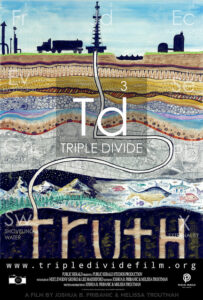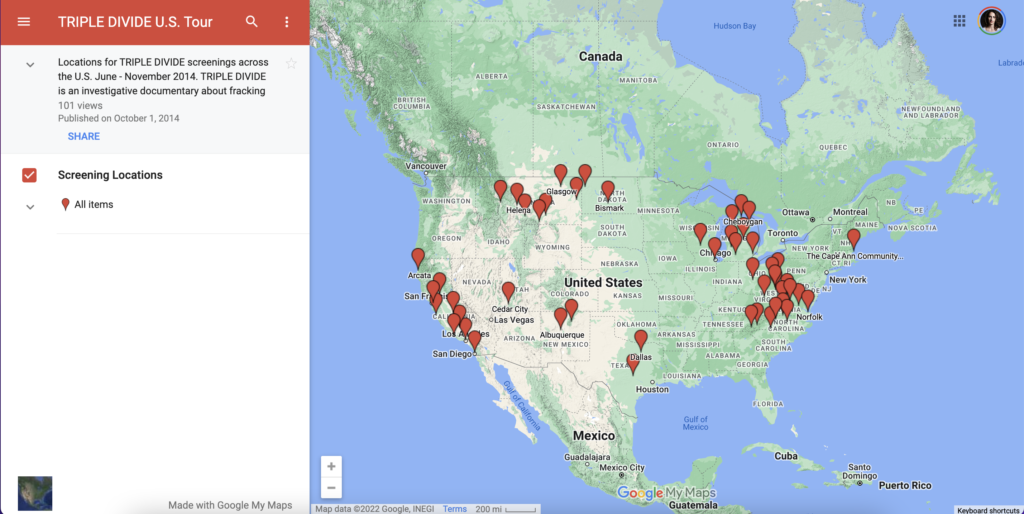by Prisca Edwards
“In Pennsylvania, we are also blessed with an abundance of natural resources: gas, timber, coal, sun, wind, fresh water, open spaces, agricultural land, beautiful scenery, and an opportune location that made us the Keystone State… To fulfill our potential, we must take full and responsible advantage of these resources.”
-Governor Tom Wolf
Pennsylvania has a history of extraction. For over 150 years companies have drilled, mined, fracked, and blown up the land for natural resources. The big ones are oil, iron ore, coal, and gas, all of this in the name of industry and economic prosperity. Throughout the generations people have risen up in solidarity to keep the energy industry in check, rallying for safer working conditions, clean drinking water, and for protection of the environment. But who controls the narrative?
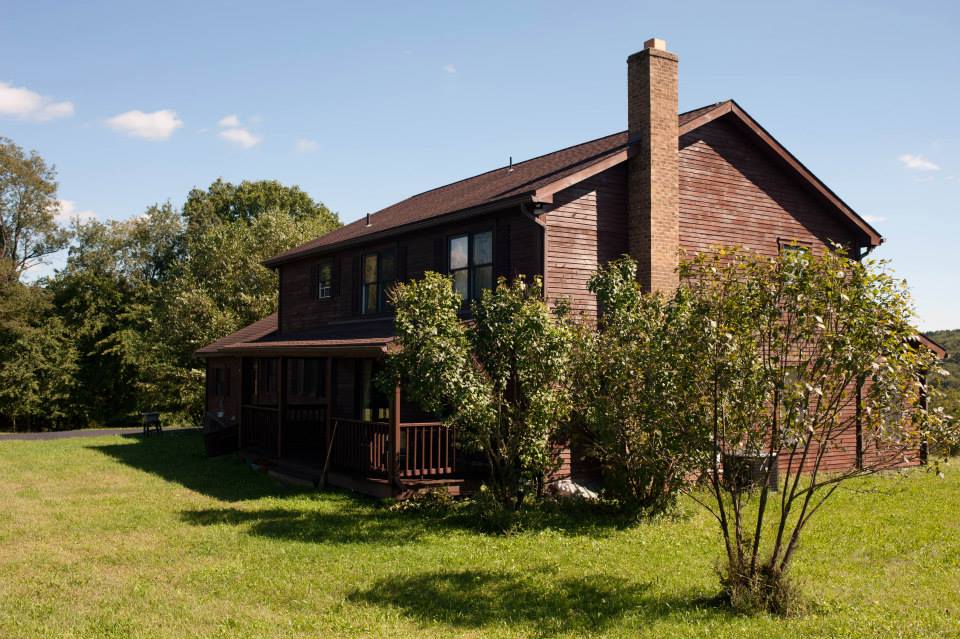
Our Fracked America
My childhood home in Butler County, Pennsylvania is situated on top of The Marcellus Shale, a formation of sedimentary rock panning from West Virginia to New York. In the early 2000’s the oil & gas industry discovered that the formation is rich in natural gas deposits. By 2010, the fracking boom had swept the nation, each new drill site another potential hazard to the neighboring drinking water and air quality. Fracking is a controversial practice of forcefully extracting natural gas from the ground. There are reports that state that the effects of fracking are harmful to the environment as well as the health of the people who live by the wells.
From a macro lens, there is a clear split between those who support it and those who don’t; those who profit from the business and those who are at risk from its impacts. Unfortunately, the people who have the most to gain from fracking are also the people who hold the most influence in shaping the narrative of its effects. According to a recent report, Pennsylvania’s oil and gas industry supports about 24,000 jobs and contributes around $583 million annually to the state’s economy. When so much profit is on the line, we’ve seen that it is the industry that speaks the loudest, proclaiming that regardless of the environmental and scientific reports published, their extraction methods are clean and safe for public health and the environment.
In 2014, the natural gas companies alone contributed significantly (hundreds of thousands of dollars) to pro-fracking governor Tom Corbett’s re-election campaign. And fast forward to 2020, when the Pennsylvania Department of Environmental Protection was under fire by the 43rd Grand Jury for the “systematic failure by government agencies in overseeing the fracking industry and fulfilling their responsibility to protect Pennsylvanians from the inherent risks of industry operations.” It’s clear that there is corruption within the industry, influencing the government, its agencies, and the media outlets.
Here is where a third cinema or a “people’s cinema” comes in. Although the practice of a third cinema was born out of the 1960s as a tool for overthrowing dictatorship and neocolonialism, the case can be made for the effectiveness of using cinema as a medium to bring the bottom up here – to share the stories of the people who live closest to the fracking sites. These are the people who are most affected but the most silenced by the oil & gas industry. These are the people who need to hear the truth. How do we get these stories in front of an audience that can enact real policy changes?
As of October 2022, Fractracker Alliance found 13,774 unconventional natural gas wells in Pennsylvania. These wells have over 63,177 recorded violations, the majority being recorded for potential harm to the environment.
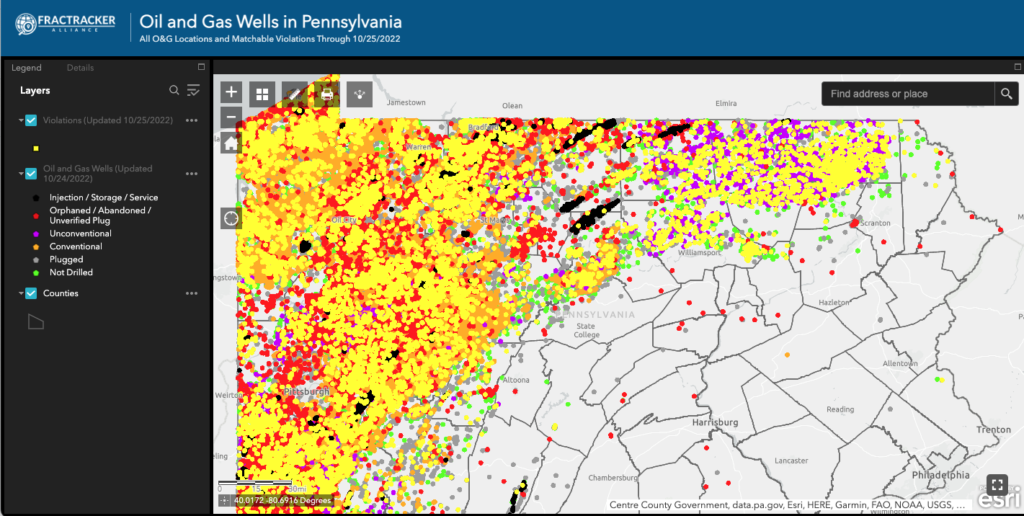
I am a photographer/filmmaker and a native Pennsylvanian. I’m currently producing a retrospective film of my parent’s story as activists in 2012 fighting off fracking in my hometown. They weren’t successful and ended up moving to New York state, where fracking is banned, leaving their home behind. Now I’m going back 8 years after they sold my childhood home and investigating the impacts of fracking in my hometown, from the people’s perspective. The influence of the industry and the promise of new jobs at the time were strong enough for the neighbors and government to ignore the inherent risks. But has it brought economic prosperity? Were my parent’s fears of their well water being contaminated realized?
I’ve researched three of the most influential fracking films of the 2010s, at the height of the fracking boom. These case studies pose as potential guides for me as I look to finish and distribute my own fracking film, keeping grassroots outlets top of mind. The research reveals what work has already been done in the spirit of third cinema and where it has left off while contrasting it with how the mainstream media and Hollywood, both influenced by capitalism, are presenting the fracking industry. Most importantly I’m interested in how these films reached (or didn’t reach) the people who needed to see them most.
I haven’t come to the end of my film yet, and I haven’t written off my hometown. Fracking has “slowed down” in the past couple of years, but there is still a need for regulations in the industry and room for change.
The people who benefit from fracking are the same group of people who third cinema was created to fight against. I hope that these film examples encourage community action and discussion in not only my film but in other films to come.
GasLand, 2010
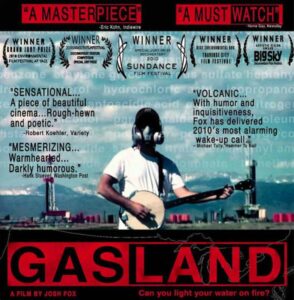
GasLand is a documentary film written and directed by Josh Fox, a native Pennsylvanian, and playwright. It’s by far the most well-known fracking film and its release was pivotal to the anti-fracking movement. Fox started the film after he was offered over $100,000 by the natural gas industry to lease his 19 acres of land in northeastern Pennsylvania for drilling. This film was his journey across America to investigate the environmental impact of fracking on local communities. The film shares stories of people who leased their land and soon after developed health problems. Even more revealing, the film questions the veracity of the statement that fracking is a clean source of energy that doesn’t harm the environment. Through the footage Josh Fox captured, it’s abundantly clear that fracking is contaminating.
Of course, the industry attacked the film saying that it misconstrued facts. However, Josh Fox responded that he “stand[s] by the film 100 percent”, and even told NPR that he questioned the wisdom of the industry to respond so publicly. Their criticism brought even more attention to the film! Even with the controversy, the film premiered on HBO and ended up winning an Oscar for Best Documentary Feature in 2011 and two Emmy Awards.
Where it shines as an example of third cinema is Fox’s touring of the film and screenings. For Fox, the real indicator of the film’s influence isn’t realized until years later. In an interview with the Center for Media & Social Impact, Josh Fox discusses the film’s goal for impact:
“It’s about how many people can we reach, how much information can I give out. Besides the film, there’s Q&As, interviews, appearances on television, all of that stuff.….We’ve been touring with GasLand and showing it to audiences as a part of the mission from before the film was finished until now three years later. And that’s why we have an impact. And because we’ve connected with all the people who are working on the issues. We’ve had an impact because we wanted to have an impact, not because we wanted to make a movie.
…. It was about connecting the dots and it originally came from the mission of the project, which was to do as big a comparative analysis [of fracking] in as many different states as we could and that that led organically to knowing all the grassroots organizations and then working with the bigger nationals organizations.”
Josh Fox embodies his role as a filmmaker and an activist. With his production company International Wow, he continues to address political and environmental crises in his work. Since “Gasland” and “Gasland 2”, Josh Fox grew into a spokesperson for clean energy, activism, and front-line resistance. His latest piece is a live performance “The Truth Has Changed”
I haven’t been able to find many videos online to see how he interacts with grassroots organizations, aside from the example below. In the spirit of third cinema, I’d be interested in attending and seeing how he incorporates the community voice and vision into the conversation.
Triple Divide, 2013
Triple Divide (2013) & Triple Divide [Redacted] (2016) are films produced by Pennsylvania journalists Melissa Troutman and Joshua Pribanic. The filmmakers founded an investigative nonprofit called Public Herald to research and report on the negative effects of fracking and how the industries were (or weren’t) responding to it. IMDb called Triple Divide a “bombshell of a documentary”. The title of the film comes from one of three triple divides across the United States. Triple Divides are points where water sources merge and potentially flow into three different watersheds, providing drinking water for millions of Americans. The film’s beautiful cinematography and combined with the eloquent voice-over, lets viewers know, from the very beginning, what this film is about; everything flows downstream. This means that fracking Marcellus Shale and its negative effects aren’t just a Pennsylvania problem.
In 2014, Triple Divide was awarded a $35,000 INNovation Fund competition award, Investigative News Network, and Knight Foundation. The award funded the Triple Divide screening tour ( map below). The production of the film itself was successfully funded with Kickstarter! After viewing the film, Tesla Motors donated one of their top electric cars to support the tour, making it possible for the filmmakers to travel 20,000 miles across the US and back without needing gasoline. As another example of third cinema practices, the filmmakers held Q&A panels after the screenings and attended local community meetings and protests against fracking.

In an interview with Our Coast Weekend in 2014 promoting an upcoming screening, co-producer Josh Pribanic states:
“The public isn’t seeing the full scale of impacts from fracking either because regulators are mismanaging the data or decisions are made based on politics instead of science. The impacts we encountered in ‘Triple Divide’ are systemic and growing, but we can learn from these experiences so that the stories of those interviewed are not in vain.” – Josh Pribanic
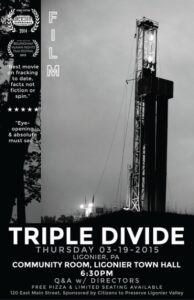
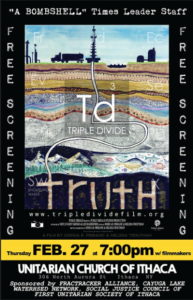
Separate from the tour, community leaders have held their own screenings and discussions of Triple Divide & Triple Divide [Redacted]. There is where I feel the impact of the film is the strongest when community members on the frontline start to gather and discuss what the inherent risks of fracking mean for their own livelihoods.
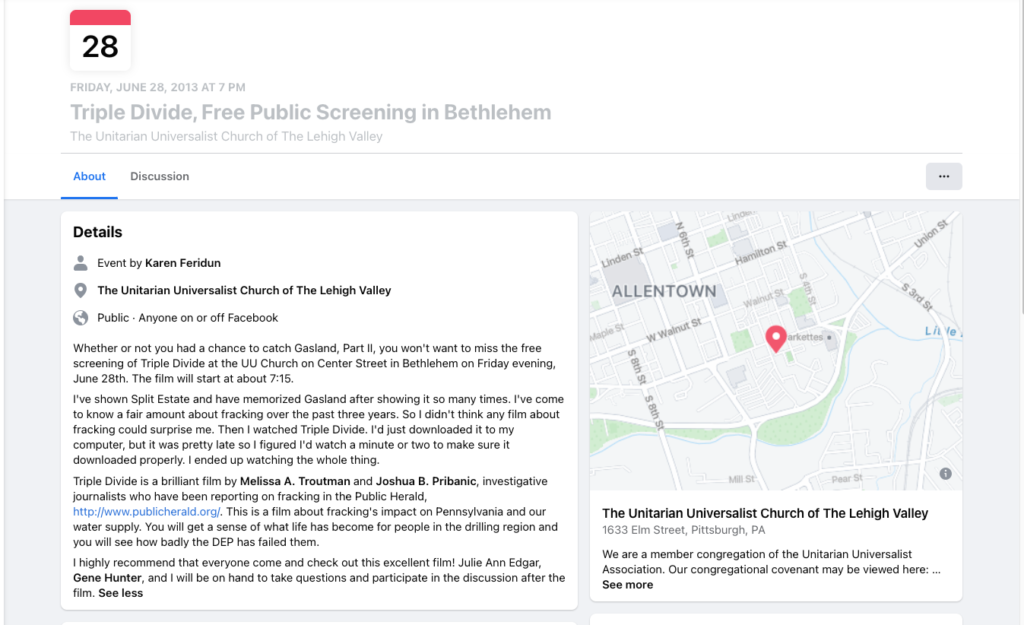
Since Triple Divide, Public Herald has continued its work in the environmental space and recently released an award-winning new film on the Rights of Land called Invisible Hand.
The Promised Land, 2012
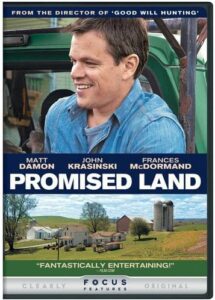 There are films in both the narrative and documentary worlds about fracking and its impacts; however, Promised Land (2012) with Matt Damon was reviewed negatively by both pro and anti-fracking organizations and failed to move the needle forward for either side. The film is based in Pennsylvania and follows two corporate gas partners as they venture to a small town to talk to landowners about fracking their land. Even before its release, the gas industry was already on defense by putting out advertisements and propaganda to help guide the conversation more into a frack-friendly direction. Interestingly enough the gas industry couldn’t find any factual flaws but published multitudes of articles to explain from their point of view. And the anti-fracking side complained that the film didn’t accurately describe what fracking is and the dangers associated with it.
There are films in both the narrative and documentary worlds about fracking and its impacts; however, Promised Land (2012) with Matt Damon was reviewed negatively by both pro and anti-fracking organizations and failed to move the needle forward for either side. The film is based in Pennsylvania and follows two corporate gas partners as they venture to a small town to talk to landowners about fracking their land. Even before its release, the gas industry was already on defense by putting out advertisements and propaganda to help guide the conversation more into a frack-friendly direction. Interestingly enough the gas industry couldn’t find any factual flaws but published multitudes of articles to explain from their point of view. And the anti-fracking side complained that the film didn’t accurately describe what fracking is and the dangers associated with it.
According to Matt Damon, the point of the film was to tell a story about real American people. In an interview with Reuters he said:
“The point is that the movie should start a conversation. It’s certainly not a pro-fracking movie, but we didn’t want to tell people what to think”
From my point of view, it seems that Hollywood got caught between sides. In an effort to tell a story in an arena that is controlled by mainstream media and big money, the message of the film was weakened. The film is a blockbuster with top celebrity names and it did have an effect to stir conversation, but is that really enough when we are talking about an issue where people’s lives are on the line? Especially when it’s distributed in the theaters and potentially has a much wider reach than independent films, it feels like a missed opportunity. While a Hollywood and non-third cinema film, The Promised Land held likely the most views but the least amount of impact on the issue. However, in the lineage of fracking films, it met its goal of being a conversation starter. It never claimed to be more than that anyway.
This is why we need more films like Triple Divide and Gasland: to give control of the narrative back to the people who are impacted the most by the effects of fracking.
Potential Partners and Distribution Outlets for further Fracking films
Here is a short list of national nonprofit organizations and grants I’ve discovered in my research. This is not an exhaustive list and as I continue working on my film I will continue to add to this list. These may be good outlets to partner with as I continue my fracking film and look for alternative methods of distribution and funding. Many of these have played a role in supporting Gasland and/or Triple Divide. Currently, the fracking conversation is becoming more and more a climate change conversation, which means that organizations campaigning for a greener planet are taking up the mantel against fracking in the 2020s as well.
- Marcellus Outreach Butler
- The Sierra Club
- EarthWorks
- The Knight Foundation
- GreenPeace
- Center for Media and Impact
- Working Films
- The Redford Center
- 350.org
- Energy Justice (Pennsylvania)
In Conclusion
These films were produced by filmmakers of different backgrounds and sponsors, however; their mission remains the same. Even The Promise Land, showed promise of telling the people’s story, but ultimately fell short. The article Third Cinema Updated by Teshome Gabriel writes that even though our society is no longer broken up easily into First World vs the Third world, there is still a need for Third Cinema films. This is because the “System”, can be replaced by “Industry” here, which is bolstered by an “us vs them” philosophy in order to thrive and continue its dominance. So far I’ve found that many screenings of these films have been sponsored by communities on a grassroots level or with a film grant. Triple Divide screenings beyond the Public Herald tour were sponsored by undergraduate student environment organizations and, interestingly, Pennsylvania churches. I’ve found that the issue of fracking is not as “black and white” as the media leads us to believe. The polarization of “republican vs democrat” starts to disappear when people need to make decisions that affect the land they own, the money they have, and their physical health.
My childhood home sold for $100,000 under its value. Being in a frack zone and in the proximity to many wells, my parents were concerned that it would lose even more value if they didn’t sell then. They also knew that the risks of water contamination would only get higher. They’ve told me that the inherent risks of living in a high frack zone outweighed the reasons for staying put. They were able to afford the move, which isn’t the case for many landowners in the area. This isn’t just an environmental issue or a water issue: it is also a social just issue. Many landowners signed leases before fully understanding the potential risks to their health and livelihoods.
As much as I’ve learned, this research has raised more questions. Was Tesla supporting the Triple Divide tour truly the best way to bring the film to the people who needed to see it? It’s clear that they needed funding, but would it have been possible to have gotten that funding from grassroots organizing and not from a corporate world whose main motivation may be to look good? Is it solely for “corporate responsibility” or does Telsa care about fracking? Or is it my socialist ideals reacting too strongly? If the right films get the funding, what does it matter who supported them? And, do these stories need a celebrity or influencer voice to aid their viewership?
Regardless, I do feel it’s important to continue the work of these filmmakers by distributing and screening films in spaces that can spark conversations among community members and government officials. Maybe the way the message gets out there isn’t as important as the fact that the message IS out there… In this fracked America and this ultra-capitalist society, perhaps the “people’s cinema” will be powerful enough to raise the bottom up and perpetuate real change. As filmmaker Josh Pribanic said when speaking about his film, I hope that these interviews are not in vain and that we, as a society, continue to learn from them. Here, for Pennsylvania and beyond, there is definitely a need for more third cinemas.

